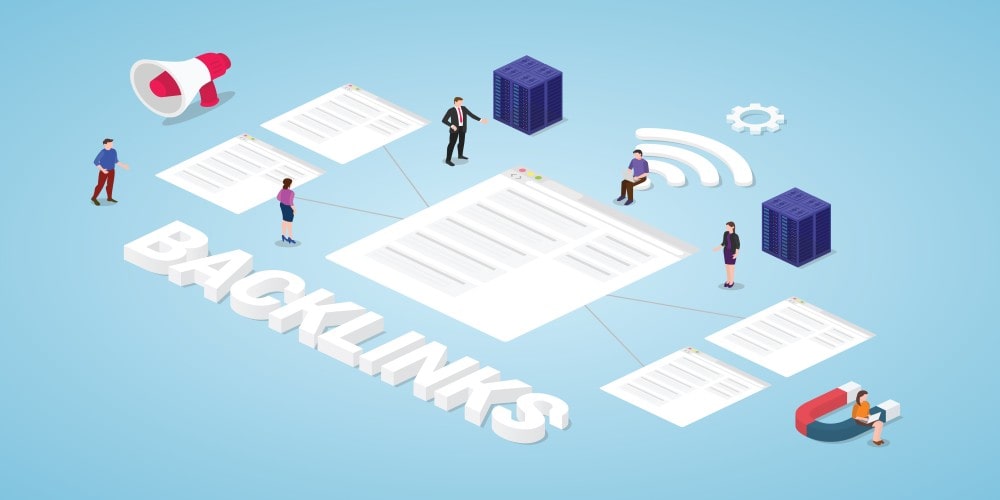Why do net linking? This question refers to the ubiquitous adage in the world of search: “Content is king, links are the queen”. This phrase accentuates the interdependence between these two pillars and invites you to find the right balance for the visibility of your company. This is why knowing what are the challenges of net linking, and what strategies should be favored to build credibility remains essential. Here are the main ways to guide you in building a long-term links-building strategy.
Table of Contents
Why do Net Linking? Definition to Better Understand
Net linking refers to promotional actions implemented by the owner of a website to increase its legitimacy. For this, the solution is to increase the number of external hypertext links pointing to your content. As long as they are relevant! Technically, net linking improves your PageRank (link analysis algorithm) or Page Quality rating (page analyzed by Google’s community of quality raters), two major performance indicators for evaluating your positioning by search engines.
Setting up a link-building strategy is the price to pay to be recognized as a respected player in your field of activity. Legitimacy is first earned in the eyes of the users of your site and then conquered by the evaluation criteria of search engines. To simplify, if a cousin theme site, recognized for the power of this content, sends users to your content via backlinks or hypertext links, you gain notoriety.
Net linking or “links building”, one of the three pillars of natural referencing
Before going any further, let’s quickly recall the pillars at the base of an organic SEO work of a website:
Content is the set of semantic elements made available on a site. Multiplying the content media (written, audio, video) makes it possible to offer a richer user experience, synonymous with better adhesion.
Net linking is inbound links that enhance your content while positioning you as a reference player in your field.
The technique is the matrix on which you propose your content. Essentially, it plays a role in the user experience. Criteria such as the loading time of your pages, accessibility, or ergonomics of your site are essential.
Develop Net Linking, A Performance Activator for Your E.A.T. Criteria
The acronym E.A.T stands for 3 inseparable criteria on which Google judges the quality of your website: E for Expertise, A for Authoritativeness, and T for Trustworthiness (credibility). These criteria, which appeared in Google’s guide to Quality Raters, aim to renew the requirement of the world’s most consulted search engine: to give users access to relevant content.
To meet these 3 criteria, it is imperative to undertake a long work of creation and mediation. This is the keystone to gain positions on the results of the SERP, or even reach the podium positions. Be accompanied by knowledgeable and trained professionals, able to gauge the relevance of links for your entrepreneurial credibility.
How to do Net Linking? The Guide in 5 Points
The challenge is to answer the question: “How to give access to the most relevant content possible to your target?” In this question, three aspects are to be prioritized:
“Most relevant content possible” is new content either by the chronology of the facts (targeted search intention, news), or by the mode of transmission (video, computer graphics, etc.), or by the quality of its narration.
“To its target”, here it is a question of determining the virtual places where you meet your target: dedicated group on social networks such as social media verification service, authority sites in the targeted field, subscribers to a newsletter, etc.
“Giving access” implies remaining attentive to the form, questioning the relevance of the anchors deployed, and transmitting in an informative way the reference to its content when communicating in a forum or a post on the networks.

1 – Content Marketing, a Powerful Lever of a Well-Thought-out SEO Strategy
High value-added net linking practices are:
Link baiting: the incoming link is collected by publishing content that has made the buzz in your community. It is the principle of the mention that operates.
The link bargain or “negotiated link”, the incoming link is generated by a partner in your field of activity, to whom you offer quality content. No fiduciary exchange between you, only a win-win exchange. You get an inbound link from a quality site and it receives rich content for its audience.
The natural backlink in a content marketing strategy. You reap it by creating original content (video, infographics, podcasts, etc.), likely to interest your target or cousin sites that will decide to refer to it in their publications. Boost this type of link by associating it with an inbound marketing strategy.
The incoming link via directories, and forums. Admittedly, quick to set up, these links remain limited in terms of traffic and gaining notoriety. However, a Google My Profile card regularly updated can generate recurring visits to your website.
Read Also:- What Technology do Search Engines use to Crawl Websites?
2 – Internal Mesh, Anchors, do Follow?
Still in line with good link-building practices, here are some techniques to know:
Backlinks in do follow: the mention “do follow” ensures the arrival of crawl juice to your page. Check the viability of your backlinks regularly. When there is a merchant exchange-type affiliate link, make sure that the “no follow” instruction is given to Google crawlers.
Link anchor optimization: Finding the right optimization ratio for your anchors can improve your net linking. Depending on your field of activity and the strategy of the competition, this indicator is to be defined on a case-by-case basis. Keep in mind that an excess of optimization can always be unwelcome by search engines.
Internal net linking: This aspect, to be favored, reflects the attention you pay to your visitors. The more you offer them links of interest to your content, the more loyal they will be. Thus, you increase your notoriety as a reference author.
After this overview of good practices, know that other uses coexist on the highly coveted net linking market. Here are some limitations and risks specific to each strategy.

3 – Net linking campaigns, a Reality with Many Faces
Recent history of net linking (from 2000 to today) shows drifts related to the exclusive search for PageRank. Without being exhaustive, this list lists practices to which you must remain attentive:
Slogs born in the years 2002/2005: These are blogs created in a fake way for the sole purpose of providing inbound links to websites to increase their Page Rank. This technique, swept by the Penguin filter in 2011, is assimilated to a Black hat strategy. The name slog comes from the contraction of spam blog, which lets you imagine the qualitative level of the content generated.
Press releases in the years 2008/2010: This format inspired by journalism is diverted from its original purpose. Published on a multitude of platforms, it has served the harvesting interests of PageRank.
Directories: hosted on platforms, they list sites and offer a link to the home page. As with press releases, satellite pages or sites, they are redundant content created for the sole purpose of bringing the user to a single page.
All these practices are known to search engines, including the giant Google.
4 – Panda and Penguin Filters, a Google answer in favor of User Experience
Deployed in 2011, these filters make it possible to fight against:
- spamdexing or algorithm manipulation techniques;
- keyword stuffing;
- cloaking or camouflaged content;
- exchanges of massive links;
- duplicate content, etc.
This infographic illustrates the path of Google’s algorithm with the gradual integration of these two filters, always towards a quality requirement for the user.
Since September 2016, the date of integration of Penguin V4, Google communicates in one direction. In general, it ignores content deemed fake that is relegated to the “Hells of the Web”. However, some of Google’s actions take the form of penalties, described in the article All about Google’s SEO penalties to avoid being a victim.
5 – Google Guidelines, Refer to it to define the limits of a Backlink Strategy
The recommendations issued in Google’s guidelines remain a framework for defining its net linking strategy. In its guidelines, Google warns against link patterns, paid links, etc. These solutions, when created solely to increase Page Rank, can negatively impact your positioning.
Note: Controversies fuel the Geosphere, especially regarding the use of satellite sites. You can read in a JDN article “Are satellite sites a risk in SEO?” The following conclusion:
“Google’s guidelines emphasize the service provided to the user by a site, rather than business models to be prohibited. […] The fact that satellite sites represent identified and real brands provide additional security.”
Today, the landscape of the Geosphere of net linking remains contrasted, with a growing number of actors aware of the user experience. In line with the guidelines of search engines, content marketing, inbound and partnership practices are the royal ways to increase link building.
Writers Column brings you informative and engaging articles and blogs in various niches. Keep Reading






[…] Read Also:- Why Using an Inbound Link Strategy is a Lever for Winning Leads, Activating your Credibility […]